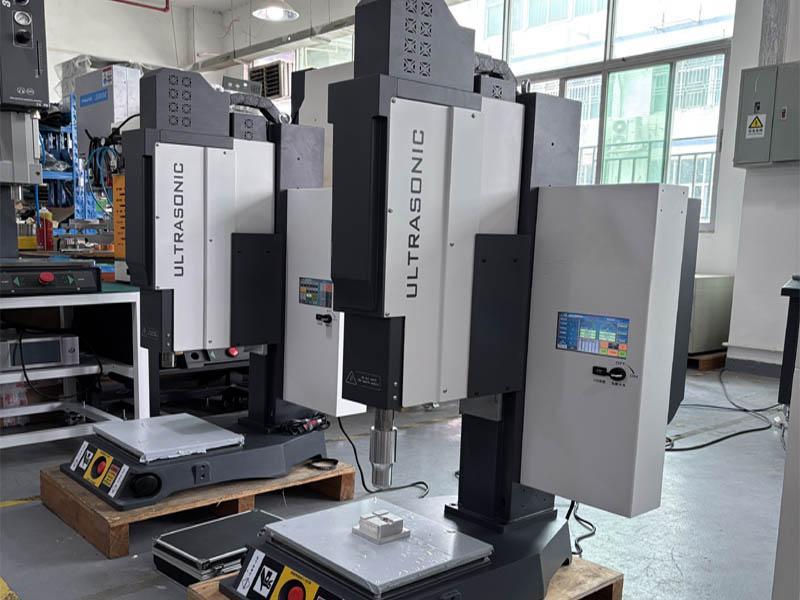Ultrasonic welding has transformed precision assembly in industries where reliability, cleanliness, and efficiency define success.
At our company, we’ve spent years refining every aspect of ultrasonic welding machines — from power supply to tooling — to help manufacturers overcome the persistent challenges that limit weld quality and productivity.
Unlike adhesive bonding or mechanical fastening, ultrasonic welding uses high-frequency mechanical vibrations generated by a transducer and transferred through a horn to create molecular fusion at the joint interface.
This solid-state process eliminates the need for consumables and achieves repeatable, high-strength welds in a fraction of a second.
Yet even the most advanced ultrasonic welding systems can encounter difficulties that compromise performance, aesthetics, or yield.
Through thousands of hours of field testing and customer collaboration, we identified the five most common problems faced by production teams — and engineered solutions that bring long-term stability, control, and confidence.
Get a free quote for ultrasonic welding machine

Inconsistent weld strength is a major quality concern in high-volume manufacturing, especially when working with complex thermoplastics or variable material lots.
The root cause often lies in unstable energy delivery, misaligned tooling, or inconsistent clamping force within the ultrasonic welding machine.
Variations in resin flow, moisture content, or molded part dimensions can further magnify these inconsistencies, producing weak or brittle joints.
Our approach begins with precision control at the generator and actuator levels.
By integrating closed-loop amplitude feedback and digital power monitoring, our ultrasonic generator ensures every weld receives consistent energy, regardless of part-to-part variation.
The actuator’s pneumatic system maintains repeatable downforce with micron-level precision, while our intelligent PLC-based controller continuously adjusts weld energy and trigger thresholds in real time.
Precision-machined fixtures keep parts perfectly aligned under the horn, guaranteeing consistent acoustic coupling across every weld cycle.
We also encourage incoming material inspection using melt-flow index verification and resin traceability — preventive measures that directly translate to stable weld strength and lower scrap rates.
When all these elements work in harmony, the ultrasonic welding system becomes a self-correcting process, delivering strength consistency that meets the strictest automotive or medical standards.
Excessive flash and deformation are among the most visible signs of poor process control.
Flash — the thin layer of molten plastic that extrudes from the joint — not only affects aesthetics but can also hinder sealing performance or interfere with downstream assembly automation.
In most cases, the issue stems from excessive energy input, improper joint design, or uneven force distribution through the horn.
Our engineers address this challenge through a combination of machine intelligence and joint optimization.
Advanced amplitude profiling within our ultrasonic generator allows for smooth ramp-up and ramp-down of vibration energy, preventing sudden thermal spikes that cause material overflow.
Our 20 kHz and 35 kHz ultrasonic welding machines feature servo-controlled actuators that precisely manage pressure and collapse distance, ensuring parts reach optimal melt flow without distortion.
We also support customers in designing energy directors and flash traps within their part geometry — structural features that capture displaced material and maintain dimensional accuracy.
Horn and booster assemblies are carefully tuned using finite element analysis (FEA) to distribute vibration evenly across the weld surface, preventing localized hotspots.
For consumer-facing components, we recommend polished titanium horns to minimize surface marking and achieve showroom-grade appearance.
By combining precision mechanics with smart energy control, flash becomes predictable, manageable, and, in many cases, completely eliminated.
Aesthetics matter — particularly in visible assemblies such as medical housings, automotive interior trims, and consumer electronics.
Poor weld appearance or micro-cracking often results from uncontrolled amplitude, excessive weld time, or the use of brittle thermoplastics with low impact resistance.
The ultrasonic welding machine’s generator, horn, and clamping system must work in perfect synchronization to prevent such cosmetic defects.
We developed multi-stage amplitude ramping within our digital generator to deliver smoother energy transitions during welding.
This gradual energy rise minimizes thermal shock and reduces surface tension differences that lead to whitening, crazing, or cracks.
In addition, our horn surfaces are mirror-polished and sometimes coated with hard chrome or ceramic to reduce friction and prevent surface imprinting.
Proper cooling of the ultrasonic stack — including transducer and booster — ensures consistent temperature stability, avoiding frequency drift that can impact weld uniformity.
When welding thin-wall or transparent parts, our ultrasonic welding systems use real-time frequency tracking and amplitude correction to maintain precise resonance, producing cleaner seams and optical clarity.
The result is a weld that looks as good as it performs — a seamless, professional finish that reinforces the value of your product.
Nothing undermines confidence like parts that appear bonded but separate under minimal stress.
Incomplete welds usually signal insufficient energy transfer, poor horn contact, or suboptimal joint design.
Our engineering philosophy begins with energy efficiency at the source — the ultrasonic generator.
Each generator is tuned to the exact resonant frequency of the transducer, ensuring maximum energy transfer with minimal power loss.
Amplitude and power calibration are automatically adjusted through our built-in frequency auto-tuning algorithm, which compensates for thermal expansion, part variation, or horn wear.
We recommend designing robust energy directors within the joint — small triangular ribs that initiate melt and promote fusion across the entire weld surface.
The horn-to-fixture alignment is verified through laser calibration, guaranteeing optimal acoustic coupling.
Our actuators include precision linear encoders that monitor collapse distance to within ±0.01 mm, confirming that sufficient material flow and bonding have occurred before the weld cycle ends.
For high-reliability applications like catheter housings or electronic enclosures, we often perform microscopic cross-section validation and weld strength pull tests as part of process qualification.
These measures ensure that every ultrasonic welding machine we deliver not only produces complete welds but also documents proof of performance for regulatory compliance.
Every ultrasonic welding system eventually experiences tool wear — a natural outcome of repeated vibration at tens of thousands of cycles per second.
Horn and booster degradation leads to uneven amplitude distribution, lower energy transfer, and unpredictable weld results.
Ignoring early signs of wear can escalate maintenance costs and downtime.
Our solution is proactive, data-driven maintenance built into the welding equipment itself.
Each ultrasonic welding machine features real-time horn frequency monitoring, allowing operators to detect small deviations that indicate wear or micro-cracks.
Our titanium and hardened-aluminum horn materials are surface-treated using nitriding or PVD coating to resist abrasion, especially when welding glass-filled polymers.
Quick-change tooling interfaces make it easy to replace or service horns without recalibrating the entire stack.
We also incorporate torque sensors and smart load monitoring in the actuator assembly, automatically flagging abnormal vibration or fixture stress.
For high-volume production lines, our predictive maintenance module connects to the machine’s PLC or MES network, analyzing vibration signatures to predict tool life with remarkable accuracy.
This digital layer not only extends horn service life but also minimizes unplanned downtime — keeping your ultrasonic welding line running at peak efficiency.
Optimizing ultrasonic welding performance requires more than just parameter tuning — it’s about understanding how every subsystem interacts within the machine.
The generator converts electrical power into high-frequency oscillations.
The transducer transforms these oscillations into mechanical vibrations.
The booster amplifies or reduces amplitude based on material needs.
The horn focuses and transmits this vibration into the part interface.
Finally, the fixture and actuator ensure precise pressure, alignment, and timing for consistent results.
When these elements are designed as an integrated system — rather than a collection of components — the outcome is a stable, predictable process that adapts to different materials and production demands.
Our ultrasonic welding machines are equipped with smart interfaces that simplify setup, allowing operators to adjust amplitude, weld time, and hold pressure through an intuitive touchscreen.
Real-time weld graphs display energy curves, collapse distance, and power usage, helping engineers identify deviations before they cause defects.
Connectivity with factory automation systems through Ethernet IP enables centralized monitoring and data logging for Industry 4.0 environments.
We also support modular system configurations — single-head bench-top units for R&D, multi-head automated stations for large-scale production, and servo-driven precision welders for critical medical assemblies.
Every configuration is built upon the same foundation of performance, reliability, and traceability.
One of the most effective ways to eliminate welding problems is to address them early in the product design phase.
Our application engineers collaborate with customers during CAD modeling to ensure part geometry, wall thickness, and joint configuration are compatible with ultrasonic energy distribution.
Using finite element analysis, we simulate horn resonance, amplitude distribution, and stress flow within the part to prevent design-related defects before production even begins.
This design-for-manufacture approach saves months of trial-and-error and results in parts optimized for strength, aesthetics, and cycle time.
For OEMs seeking to scale production globally, we offer standardized ultrasonic welding platforms across frequencies (20 kHz, 30 kHz, 35 kHz, and 40 kHz), ensuring consistent process performance no matter where the machines are deployed.
The future of ultrasonic welding lies in intelligent process control, data analytics, and sustainability.
Modern ultrasonic welding machines already consume less energy than thermal or adhesive methods, but digital optimization is unlocking even greater efficiency.
By integrating sensors for temperature, force, and acoustic response, our next-generation systems can automatically adjust parameters mid-cycle to compensate for material or environmental variations.
Machine learning algorithms will soon correlate weld data with long-term field performance, predicting failures before they occur.
This convergence of automation, connectivity will redefine how manufacturers view quality control — turning every ultrasonic welder into a self-optimizing production asset.
Ultrasonic welding remains one of the fastest, cleanest, and most sustainable methods for joining thermoplastics in modern manufacturing.
However, its full potential is realized only when equipment, process, and design converge under expert guidance.
By tackling these five key challenges — inconsistent weld strength, flash and deformation, poor appearance, incomplete welds, and tool wear — we’ve built ultrasonic welding machines that deliver consistent, high-integrity results across industries.
Whether you manufacture medical devices, automotive components, or consumer electronics, our commitment is the same: to provide ultrasonic welding solutions that combine precision, intelligence, and reliability.
Because in today’s manufacturing landscape, true innovation isn’t just about making stronger welds — it’s about building smarter machines that make better products, faster.
Phone: +86-15989541416
E-mail: michael@sztimeast.com
Whatsapp:+86-15989541416
Add: 3/F, Building 5,Huixin Intelligent Industrial Park, Xinhu, Guangming, Shenzhen,China 518107
We chat
